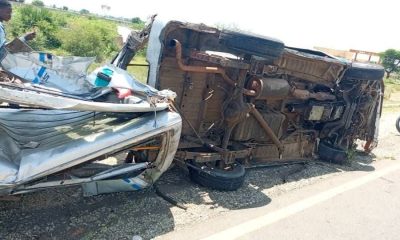Crash News
FRSC Reports 23.1% Drop in Road Traffic Deaths Across Nigeria (Jan–Sept 2023)

In a development that has sparked cautious optimism across the nation, the Federal Road Safety Corps (FRSC) has announced a significant 23.1 percent reduction in road traffic deaths within the first nine months of 2023.
Also Read: FRSC Corps Marshal Calls for Firearms: Will Guns Make Nigeria’s Highways Safer?
Between January and September 2023, Nigeria recorded 7,830 crashes, a sharp decline from 10,039 during the same period in 2022, according to official FRSC statistics.
The Corps attributes this positive trend to enhanced patrol visibility, increased enforcement, driver education campaigns, and improved collaboration with transport unions and state agencies.
Yet, despite the encouraging figures, thousands of families continue to mourn victims of Nigeria’s hazardous highways, reminding us that while progress has been made, the war against reckless driving and poor road infrastructure is far from over.
This article investigates what led to the decline, examines ongoing challenges, and explores what must happen next to sustain and expand these safety gains.
According to the FRSC’s official data:
- 7,830 road crashes occurred between January and September 2023.
- 10,039 crashes were recorded in the same period in 2022 — a drop of 22 percent.
- Fatalities decreased by 23.1 percent, while injuries dropped by roughly 21.3 percent.
(Source: IndependentNG; PulseNG).
The Corps Marshal, Dauda Ali Biu, said the FRSC has been implementing Operation Zero Tolerance to Road Traffic Violations, focusing on major high-risk routes such as:
- Abuja–Lokoja–Benin corridor
- Lagos–Ibadan expressway
- Kano–Zaria–Kaduna route
- East–West highway and the Enugu–Port Harcourt corridor
These routes, notorious for fatal crashes involving fuel tankers, overloaded buses, and poorly maintained trucks, have seen increased patrols and technology-assisted monitoring.
While the FRSC’s national figures show overall progress, the improvements vary across regions:
| Region | 2022 Crashes | 2023 Crashes | % Change | Key Contributing Factors |
|---|---|---|---|---|
| South West | 2,541 | 1,982 | -22.0 % | More speed checks, joint patrols, fewer night journeys |
| North Central | 1,999 | 1,520 | -23.9 % | Major highway repairs, fewer tanker fires |
| North West | 1,724 | 1,438 | -16.6 % | Improved enforcement, better weather |
| South South | 1,338 | 1,081 | -19.2 % | Public education campaigns, fewer overloaded buses |
| South East | 1,138 | 809 | -28.8 % | Increased awareness drives, community traffic marshals |
| North East | 1,299 | 1,000 | -23.0 % | Less insurgency-related road disruption |
(RoadKing analysis based on FRSC regional data and interviews.)
These numbers show that while overall crash incidents are falling, the improvement is uneven. For instance, states like Ogun, Oyo, Niger, and Kaduna continue to record high fatality rates due to heavy commercial transport activity and poor road surfaces.
Why the Decline Happened
1. Intensive Enforcement Campaigns
The FRSC increased highway patrol frequency and introduced Body-Worn Cameras (BWCs) to monitor officers in real time. This step reduced corruption and ensured consistent enforcement of seatbelt and speed-limit regulations.
2. Technology Integration
The National Vehicle Identification System (NVIS) and Speed Limiter Device Compliance Portal helped track offenders, while drones and automatic number-plate recognition systems were piloted on key highways like the Abuja–Kaduna and Lagos–Ibadan corridors.
3. Public Education
Between January and September, the FRSC organized over 1,500 road-safety workshops and motor park rallies, reaching more than 500,000 commercial drivers nationwide.
In partnership with NURTW and RTEAN, the campaigns emphasized fatigue management, seatbelt use, and vehicle maintenance.
4. Increased Collaboration
The Corps worked closely with the Federal Ministry of Works, State Traffic Agencies, and private transport unions, leading to the repair of black spots such as the Ojuelegba Bridge approach and Lokoja–Abuja corridor, both of which previously recorded multiple tanker crashes.
5. Improved Emergency Response
The establishment of more FRSC Emergency Ambulance Service Centres (ZEEMS) along busy corridors drastically cut response times. Victims who would have otherwise died before reaching hospitals now stand a better chance of survival.
Still, Nigeria’s Roads Remain Among the Deadliest in Africa
Despite the encouraging decline, Nigeria still ranks among Africa’s top five nations with the highest rate of road traffic deaths per 100,000 people, according to the World Health Organization (WHO, 2023).
Key contributors include:
- Over-speeding: Responsible for nearly 52 percent of all fatal crashes.
- Fatigue & night driving: A common cause of long-distance accidents involving buses.
- Poor road infrastructure: Craters, failed sections, and narrow shoulders contribute to secondary collisions.
- Vehicle condition: Many public transport vehicles operate without valid roadworthiness certificates.
- Human error: Reckless overtaking, distracted driving, and alcohol consumption continue to take lives.
(Sources: WHO Global Road Safety Report 2023; FRSC Quarterly Report Q3 2023.)
In July 2023, a Toyota Hiace bus carrying 18 passengers collided with a tanker along the Abuja–Lokoja highway. Eleven people died instantly.
In August, four university students lost their lives on the Enugu–Abakaliki expressway when their tricycle ran into a stationary truck.
And in September, a father and his two children were killed when their car plunged into a ditch on the newly reconstructed Onitsha–Owerri road due to missing guardrails.
Each statistic is not just a number, it’s a family torn apart.
That is why, despite the FRSC’s success, RoadKing.ng insists that policymakers must humanize these numbers and translate progress into safer experiences for everyday road users.
Transportation Safety Analyst – Engr. Chidi Obinna:
“The reduction is commendable but should not blind us to systemic issues. We need sustainable engineering interventions, not just seasonal enforcement.”
Public Health Expert – Dr. Kemi Bello:
“Every road death is preventable. Nigeria’s roads will only be truly safe when drivers understand that recklessness is not bravery, it’s a form of suicide.”
Commercial Driver – Mr. Ibrahim Bello (Jabi Park):
“We see FRSC people more now, especially during festive periods. Some drivers still think they can bribe their way, but things are changing slowly.”
These perspectives show that while awareness and enforcement are rising, behavioural change remains the hardest battle.
Comparing With Other African Nations
| Country | Estimated Road Deaths (2023) | Road Deaths per 100k Population | Primary Causes |
|---|---|---|---|
| Nigeria | ~34,000 | 33.7 | Over-speeding, poor road design |
| South Africa | ~12,000 | 20.9 | Alcohol, fatigue |
| Kenya | ~4,800 | 19.7 | Reckless matatus |
| Ghana | ~2,900 | 14.2 | Poor vehicle maintenance |
| Egypt | ~5,000 | 12.3 | Urban congestion accidents |
(Source: WHO 2023 Global Status Report; African Road Safety Observatory.)
The table shows that although Nigeria has made improvements, its road fatality ratio remains one of the highest globally, especially when adjusted for population and vehicle density.
What RoadKing.ng Observed
Our correspondents who travelled across Ogun, Niger, Kogi, and Cross River States report that:
- Many black spots identified years ago remain unrepaired.
- Reflective lane markings and night visibility signs are missing on many highways.
- Tanker drivers continue to park indiscriminately on road shoulders, creating ticking time bombs.
- Rural feeder roads linking expressways are in deplorable shape, leading to frequent head-on collisions.
Until these infrastructural issues are addressed, the progress recorded by the FRSC may not be sustainable.
The FRSC’s long-term vision, according to Corps Marshal Biu, is to achieve a 50 percent reduction in road traffic deaths by 2030, aligning with the United Nations Decade of Action for Road Safety.
To reach that goal, experts suggest:
- Establishing a National Road Safety Fund to finance infrastructure safety upgrades.
- Integrating road safety into school curricula, especially for young drivers.
- Mandatory advanced driver training for all commercial transport operators.
- Legislation on vehicular age limits, restricting commercial use of vehicles older than 15 years.
- Deployment of intelligent traffic systems to detect speeding and lane violations automatically.
At the grassroots, local councils can do more by:
- Installing solar-powered streetlights on dangerous curves.
- Creating community traffic volunteers, especially near markets and schools.
- Supporting annual “Safe-Driver Week” campaigns with FRSC and RoadKing.ng partnership.
When citizens take ownership of road safety, national statistics transform from government figures into a collective civic success.
The FRSC’s report is a beacon of hope but also a warning.
Yes, Nigeria has recorded a 23.1 percent decline in road deaths, yet tens of thousands still perish every year on its highways.
To sustain progress, the government must combine infrastructure renewal, strict enforcement, and driver reorientation with continuous public engagement.
For every safe kilometre travelled, countless lives are preserved, lives that fuel families, businesses, and the very engine of Nigeria’s economy.
As the FRSC continues its campaigns and Nigeria invests in safer road networks, RoadKing.ng will remain on the frontline, reporting, analyzing, and amplifying the truth about what really happens on our roads.



















